|
|
|
 |
|
 |
|
Proclaim was a story of its own. We like innovative stuff and Dan Herrington makes it. He has a background in car audio. After winning many first prizes for his techniques in this territory alien to us, he set himself a new challenge. On the way back from a show where he was voted world champion in the car audio field, he jotted down his idea on four pages of paper. The result a few years later now is a loudspeaker system fully adaptable to the room. Dan's years with the limited space of cars where one way or another you're expected to deliver a soundstage and all other things 'audiophile' rather than cheap boom boom, he learned much about acoustics. This now birthed a loudspeaker system with individually adjustable drivers and a tunable external active crossover. The loudspeakers are mounted in spherical housings. To deaden the spheres, they are twin walled, with the woofers having a full inch gap filled with sand for dead enough. The midrange and tweeter spheres are mounted on adjustable arms to be positioned for time alignment and room interaction.
|
|
|
 |
|
Lastly, the active crossover provides individual L-pads to adjust midrange and tweeter output. Once the settings are to the listener's satisfaction, the L-pads can be overridden with jumpers and fixed resistors. Being a man that really thinks out of the box and comes from outside the audiophile religion, Dan's car even tows a trailer in which he can demonstrate his DMT-100 speaker system. And it is worth your while. In his room he paired with Al Stiefel's Red Rock Audio triode amplifiers and the result was complete system and room synergy we only heard in one other room later on. With the DMT-100's flexibility to adapt to the quirks and idiosyncrasies of the room, the result was music all around the room, not just in the so-called sweet spot. Walking around merely changed perspective, nothing else. Musicians remained put on the virtual stage without performing a magical David Copperfield dislocation trick. Proclaim needs more attention soon we think.
|
|
 |
|
T-class to the max - that was Audiomagus' battle cry, from a battery-fed Trends (making a huge difference) to their own Kingrex electronics. Johnny Blue micro speakers behind Lovecraft/Cain & Cains.
|
|
 |
|
 |
|
Reference Audio Mods are known for their tweaks, especially their power supply modifications. This year all of the equipment was battery powered. Behind the racks, nice wooden boxes held all the required batteries. Loudspeakers were the PHY-HP based Tonians. Tony Minasian also let us hear something else. He has read our contributions to CD enhancements but now can and does go a big step further. In his opinion, the poor quality of CDs is not the media itself. It is the recording. What exactly he does is not completely clear to us at this point, but he played us some tracks from a CD he recorded. With only some dithering and no compression at all, what he played was truly amazing and startling. True dynamics is the only suitably gasping response we can make. Tony promised us to get back on this and send us a sample CD. When we know more, we'll of course report on it.
|
|
 |
|
|
 |
|
|
In the Studio Electric room, it was plain and simple but shiny: playing music just for fun.
|
|
 |
|
|
|
Eastern Electric's $7,000/pr M-156 monoblocks with Shuguang's reissues of the legendary pentodes were driving VMPS RM V60 ribbon loudspeakers with good results from a hard disk and squeezebox source. With the amount of PC-oriented sources at the show, there must in the near future come a point that sees the traditional audio CDP reduced to a diehard artifact. [M-156 monos to be reviewed by John Potis once first shipments land on American shores - Ed.]
|
|
 |
|
|
 |
|
|
In the Cardas room, it was Joule Electric, Merlin loudspeakers and green shrubs.
|
|
 |
|
|
|
With the passing of Terry Cain, the Cain & Cain company rises from the ashes as the Lovecraft phoenix.
|
|
|
 |
|
|
|
Also on display was the Noogie desk top system and the Gordon Rankin-inspired Walla Walla Wall of Sound - W3.
|
|
 |
|
|
 |
|
|
Escalante Designs showed the larger Fremont loudspeaker besides the small Pinyon. Though we love the Fremont, the smaller sibling shares a great deal of its charms.
|
|
 |
|
|
|
Sound Science made things big. On display was the Acoustic Line Array Acoustic Lens with waveguide, an interesting concept we had not seen before. The combination of a guide and line array creates a column of sound that expands until it hits boundaries. They demonstrated Lyngdorf's room-tuning electronics in combination with their small dipole loudspeakers on, yes, open baffles.
|
|
|
 |
|
|
|
The Harbeth Monitor 40 is just one of those speakers that do what they should do - make music.
|
|
 |
|
|
|
Here a pair of small MBL speakers was playing at eardrum-preserving normal levels, not always a given with this brand.
|
|
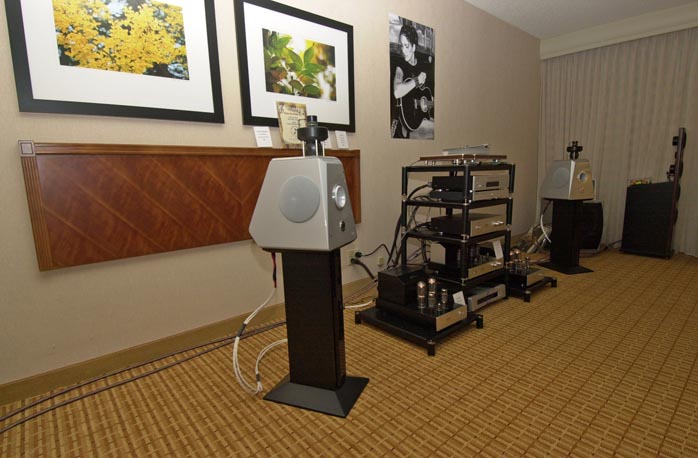 |
|
|
|
Surprise, another open baffle speaker. This time it was a prototype of the Balanced Power Technologies 3-way. It used a Scanspeak 6600 AirCirc tweeter in a parabolic wave guide with a SEAS W22EX 8" midrange mounted in the open baffle while the bass was handled by a Focal 6452 in a dual-chamber housing. The crossover was external and can be passive and/or active. Running on filtered power, the laptop in combination with TacT pre and power amps including room correction made for a very pleasing combination.
|
|
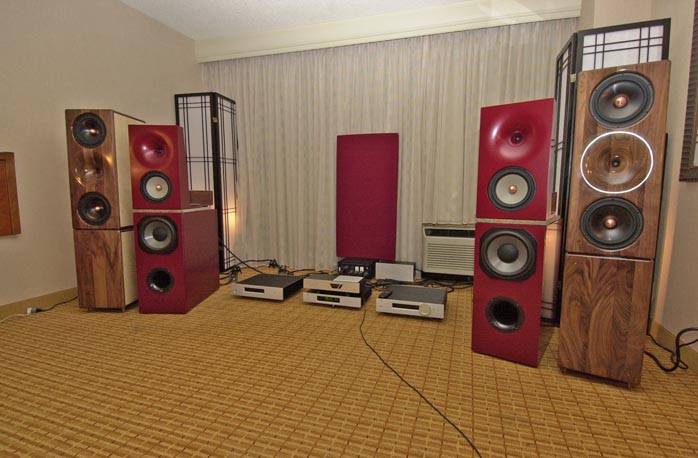 |
|
|
 |
|
|
In this room, the Wilson Watt/Puppy sounded like - yes, Wilson.
|
|
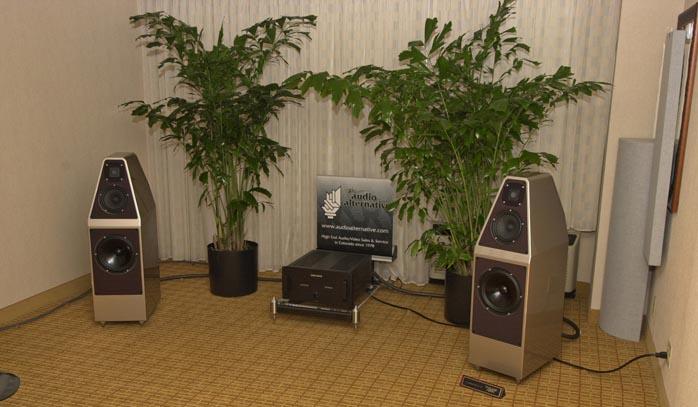 |
|
|
|
When you like plain -- that is, not as in vanilla -- and simple, you'll like Audio Note UK. It was funny to see that the PC music source has finally even entered this tube bastion.
|
|
 |
|
|
|
Audio Note UK's Ongaku in combination with a Mårten Coltrane Supreme and a Brinkman Balance turntable was a combination you can almost only see and hear in Denver. It makes you forget sore feet, an empty stomach and airport security regulations.
|
|
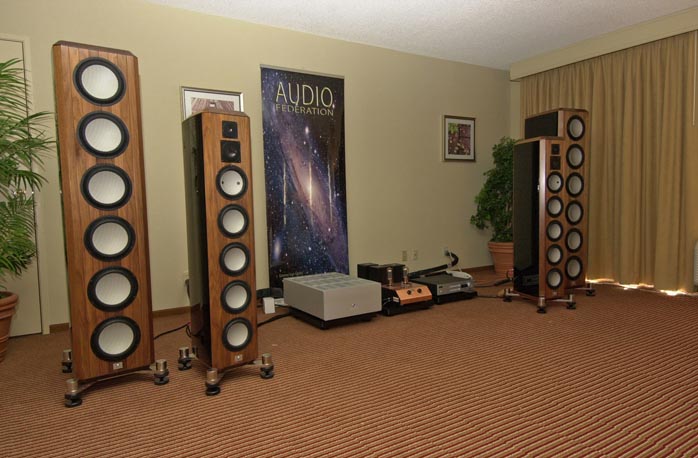 |
|
|
|
E.A.R too entered the speaker fold this year. And guess what -- no, better don't -- it also is an open-baffle 3-way.
|
|
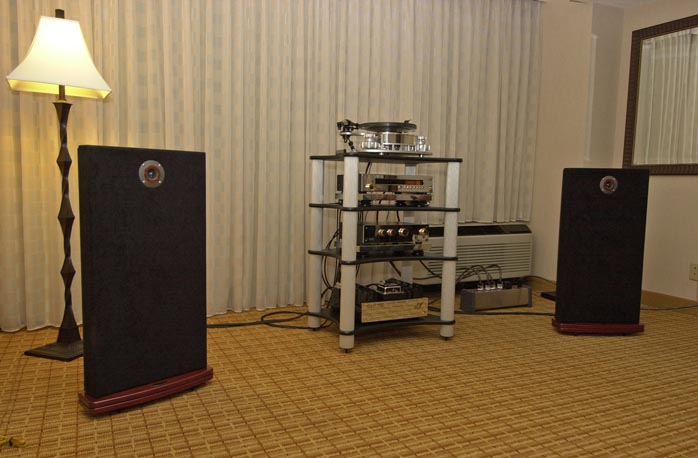 |
|
|
|
 |
 |
|
|
 |
|
|
|
|
|
|
|
|